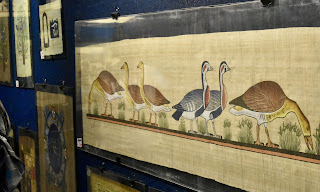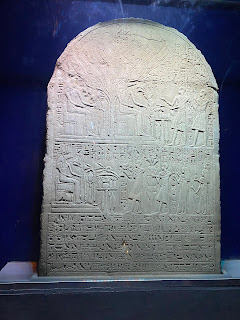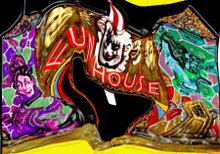Day 9: Sept 5 Part III The Papyrus Institute and Kom Ombo
Our next stop before lunch was the Papyrus Institute. There we got to learn how they made the papyrus in olden days (and how they make it now.)
Papyrus plants that used to grow plentifully along the Nile in ancient times had pretty much died out in Egypt by the 18th century, but plants were sent to Egypt from France in 1872 (and I think also from Syracuse). In 1962 a man named Hassan Ragab invented a modern process that allowed for limited production of the paper-like substance.
The pulp of the plant is laid in two layers. One layer is horizontal and then the next layer goes across the first layer vertically. After that it is then pressed. (You can see a hand press in the foreground of the shot below).
There were many lovely examples of painted papyrus for us to look at and of course to purchase. Remember these geese from the Egyptian Museum?
These trees of life are also quite lovely.
Our group chatted and enjoyed the atmosphere before climbing back into the bus to go back to the ship for lunch.
There were as always a few interesting things to see out the window.
...and eventually we found ourselves back at the dock and boarding the MS Antares
We had a restful luncheon.
It was a late lunch but all the more appreciated for that reason.
The waiter here is called Little Mohammed, because there are so many Mohammeds.
and the ship set sail for Kim Ombo which is only about 30 miles north of Aswan.
We got off at Kim Ombo. Here is the Google Earth overhead shot just so you can get your bearings.
This web site also has a very nice map that labels the various buildings and remains of buildings. It should be rotated clockwise 90 degrees to correspond with the imager above.
The temple is ptolemaic, having been built around 180-47 BCE by a series of Ptolemies. This is the first structure that you see, a kind of double portal to the temple that was actually a kind of double temple dedicated to two different gods.
The box in front is probably the remains of an altar found in the courtyard of Augustus.
The temple is perfectly symmetrical along its north south axis and the southern part is dedicated to Haroeris the falcon god of Horus the elder.
Again you can see the leaf-like decorations on the capitals in the hypostyle hall of Ptolemy XII that indicate ptolemaic tastes.
We arrived just before dusk and the long shadows of the day enhanced the sense of the height of the pillars and the other vertical lines.
The southern part of the temple is dedicated to the crocodile god, Sobek.
Kom Ombo was a temple dedicated to healing and there are many indications in the gods honored and in the hieroglyphic texts to show that this was the case.
This would be the part dedicated to Harris (on the left side of the double temple.)
Our guide explained to us about the culture of the healing temple.
There is still some evidence of the beloved blue color so often found in ptolemaic temples as seen here on this pillar
Here we see the king in the double crown of upper and lower Egypt making an offering.
And the pillar below shows Sobek, the crocodile god wearing the shuti double-plumed (falcon feather) headdress often associated with Amon, but also frequently seen on Sobek.
One of the most famous aspects of this Temple of Healing is that there are medical instruments portrayed on the walls.
The panel referred to in the sign can be seen below.
This web site has a nice labelling of the various items.
Here are images from the Harris section of the temple showing the elder Horus and Ma'at being honored by the King.
This seems to be a purification as the King has watered poured over him by both Horus and Thoth. On the right the two parts of Egypt crown the King with their crowns.
Near the temple is also the Crocodile museum.
Many embalmed crocodiles were found in this area, dedicated no doubt to Sobek in prayers for healing.
There are some lovely artifacts there.
Below is a nice depiction of Sobek.
Here are some mummified crocodiles in the museum.
This is quite an unusual depiction of an animal god!
Of course these gigantic crocodiles were the most imposing and impressive part of the museum.
We got back and had our port talk before enjoying a lovely dinner.
Those of us that had ordered jewelry from the ship's jeweler were also getting our orders. My friend below found something absolutely gorgeous in the upstairs window and it suits her perfectly!
After long days we were very serious about our dinner!
Isn't this beautiful?!
Then it was back to the room to get a good night sleep. We would not have to leave as early as usual tomorrow, but we were tired from a successful, but long day.





































































No comments:
Post a Comment